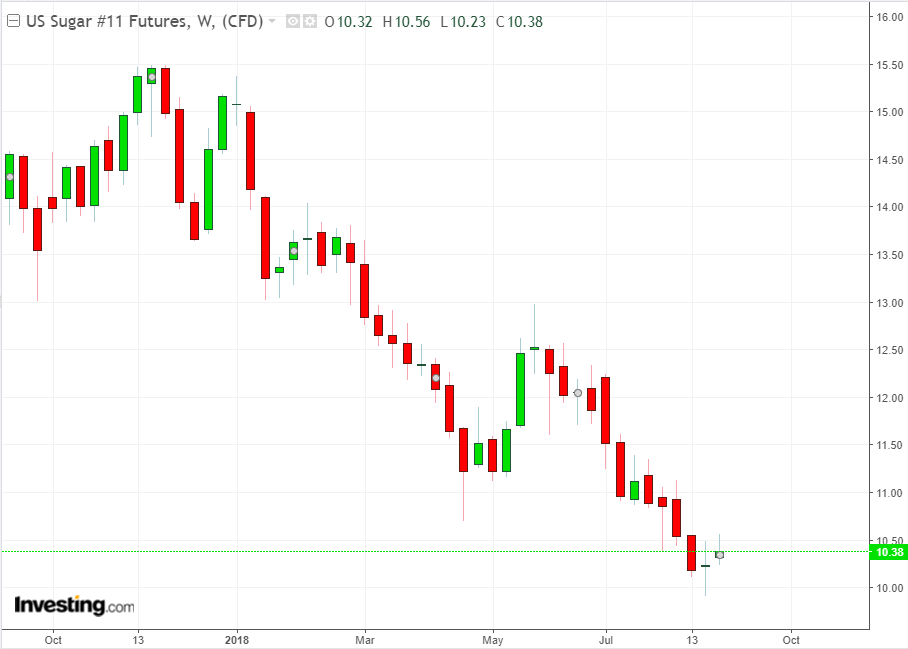Do you drink coffee by the pots and like it sweet? Even if you do, that’s unlikely to lift the arabica market from its current doldrums, or send a lifeline to sugar, which is also at multi-year price lows despite the planet’s eight billion people consuming the sweetener. Yet market bears who insistent on suppressing the two staples may be in for a shock as a sharp price snapback may be in store, analysts warn.

The market for any commodity is based on supply and demand. With the exception of extreme US shale crude oversupply events, such as what occurred in 2016, and global financial crises, like the 2008/09 crash, the price of oil—the commodity which powers and moves the world—has been largely dictated by fundamentals, and occasionally technicals. But arabica coffee and sugar might be getting hammered beyond both those matrices now. It's highly possible negative sentiment is now driving declines.
“Getting too bearish at the current lows in the sugar and coffee futures market could turn out to be a very costly mistake for traders and investors,” veteran commodity markets participant and analyst Andrew Hecht cautioned in a blog on Tuesday.
A Price Recovery Long Overdue
He cites two key red flags for sugar and coffee bears:
- While there is a glut in both now, potential crop diseases and unfavorable weather could lower harvests by the next season.
- Protracted losses since 2016 have pushed futures of the two markets into oversold territory on long-term charts, and a price recovery is long overdue.
Coffee’s hold on the world as a beverage and the critical importance of sweeteners to daily life are also being ignored in the base pricing of the two raw materials, said Hecht, reiterating the International Sugar Organization’s recent warning of a massive inventory drawdown that could cut global sugar stocks by 800,000 to 6.81 million tons.
“It is almost impossible to pick a bottom in any market, and while both sugar and coffee futures have declined to their lowest levels in many years, continued weakness in the Brazilian currency could send them to even lower levels,” he wrote.
“However, risk-reward and the nominal price levels of both agricultural products together with the many other factors that determine the path of least resistance of prices favor price recoveries. Additionally, both sugar and coffee futures market have a long history of wild price variance at times. It is not unusual for prices to double half or more in short time spans.”
Energy Strengthening Bid For Sugar
In Tuesday’s session, sugar for October delivery on ICE Futures US settled down 2.3 percent at 10.32 cents a lb, after striking 10-year lows at 9.91 cents earlier. For the year, the market was down 32 percent, with nearly two-thirds of the losses accrued in the past three months. Investing.com’s daily technicals maintained a “Sell” on sugar with buying only projected if the contract returned to the 10-day moving average of 10.23 cents.
“Sugar prices are trading under their 20 and 100 Day Moving Average as the trend remains to the downside, but we are starting to squeeze blood out of a turnip, in my opinion, as even coffee prices have rallied in recent sessions,” said Mike Seery, commodities chartist at Seery Futures in Plainfield, Illinois.
He said investors also had to keep in mind the other fundamental importance of sugar: as the biofuel ethanol, which was mandated in the US to be a 10 percent additive to gasoline.
“If you take a look at crude oil, sugar used as a biodiesel looks very cheap,” Seery said. US West Texas Intermediate crude, while on course to end August down for a second straight month, is still up 13 percent on the year.
ADM Investor Services made a similar observation, saying “Brazil's Center South mills have been favoring ethanol production over sugar this season,” and that “strong energy prices have been supportive outside market forces” to sugar.
Bullish Signal Already In For Coffee
In coffee’s Tuesday trade, arabica for December delivery on ICE Futures US returned below the key $1 per pound level, after 12-year lows of 99.35 cents were seen last week. For the year, the market was down 18 percent, with virtually all of those losses accrued over the past three months.
While pre-Wednesday’s electronic trade brought December arabica back to a session high of $1.0653, Investing.com’s daily technicals maintained a “Sell” on coffee. Strong buying support was only seen if the contract returned to the 5-day moving average of 99.83 cents.

But some think a buy signal in arabica was already evident after the market’s ride below the $1.02/lb level last week. “Supply/demand situation in coffee in this on-season year is the most bullish we have seen in history,” said Shawn Hackett of Hackett Financial Advisors in Boca Raton, Florida.
Hackett said his analysis showed coffee prices were falling in tandem with the slide in the Brazilian currency, the real, not for any other reason. “Since March, both the real and coffee prices are down an identical amount. All the nonsensical stories about huge supplies, record crops etc. have all been made up.”
He estimates that 3 million to 5 million bags of coffee have already been reduced from the 2019 off-season crop potential, with more losses likely on the way if forecasts for a drier than normal flowering season is verified.
“Coffee will need to price this huge shortage coming in the 2019 crop season now to revitalize current coffee farmer investment apathy to future crop production. End users and traders should be protecting upside prices risks at this time.”
